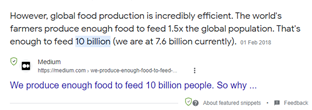The Myths of Overpopulation that Lead to Populationism
As the world's human population increases exponentially, at a rate so quickly that it doubled, going from 4 billion to 8 billion, in only the past 50 years, there have been many discussions around what that means in the long run and what should be done about it. One of the major responses is populationism, an ideology that agrees with population control and implementing population policies. More recently however, feminist scholars like Bhatia et al. (2020) say that the conservations of populationism are too globally focused and without enough recognition of the effects of populationism beyond reproductive health policies. To counter this, they have conceptualised multiple different motivations and manifestations of populationism.
The first one is demopopulationism which speaks to trying to achieve an optimal demographic distribution in a given group, potentially determined by a myriad of characteristics. The three key processes associated with this are the researching and recording of the group's demographic information, the unequal manipulation of different groups fertility rates to encourage some's while discouraging others' reproduction and the promotion of internally motivated reproductive control within the undesired group to have them police and inhibit their own reproduction. The discourses around whether poor people should have children would fall under this category. The argument that children don't deserve to grow up in poverty and thus poor people shouldn't have children has identified poor people as the undesired demographic and then proceeded to encourage said demographic to regulate and limit their own reproduction, motivated by the 'for the children' ethics of it. What this argument ignores is that reproductive rights include the choice to have children and the necessary resources to make that a safe choice for the children, that poverty is not an innate or inevitable trait and thus there are other solutions to not wanting children to grow up in poverty and that poverty is highly associated with other marginalisations, like race, sexuality and disability.
The second one, geopopulationism, speaks to the direct and indirect population control cause by space making processes. This encompasses containment, forced displacement and unequal resource access. Thus Apartheid would be a form of geopopulationism. The government identified its desired and undesired demographics, White people and non-White, especially Black people, respectively. The Group Areas Act of 1950 was the version of containment because it allowed them to position White people as free-moving residents of nicer areas and Black people as restricted residents in overcrowded and less resourced areas. This law was also the basis for their version of forced displacements, the regular forced removals, utilised to remove non-White people from areas that were deemed too nice. In the racialisation of areas came the unequal distribution of resources. An example of this would be the Bantu Education Act 1953 which, in addition to limiting Black people to a lower quality education, placed the better resourced schools and universities in White areas to make them a lot more accessible to White people, even after the laws began to relax.
The third one is biopopulationism and it speaks to the desire for an increased quality of life consequent from an overly selected and invaded reproductive process. Often this speaks to practices like early detection of disability to allow for abortion in attempt to only have healthy children. This manifested itself in China's single child policy. Because people were only able to have one child, they were forced to have a quality over quantity approach to family planning and this resulted in a spike of fetus and infant femicide as well as a great increase in the number of female babies put up for adoption. The thought process being that sons have better economic prospects and thus would be a better financial investment.
 |
| Figure 2A: Statistic on Lowest Resource Consumers per Capita https://www.overshootday.org/how-many-earths-or-countries-do-we-need/ |
 |
| Figure 2B: Statistics on Highest Resource Consumers per Capita https://www.overshootday.org/how-many-earths-or-countries-do-we-need/ |
Avengers: Infinity War's (2018) main antagonist, Thanos (Figure 3), used this as motivation for his populationist beliefs and spends the entirety of the movie trying and ultimately succeeding to wipe out half of all living things across the universe as a means to better resource those who remain. The sequel Avengers: Endgame (2019) tackles with the consequences of that and shows how it was an ultimately flawed approach. Killing half of all the cows, for example, while killing half of all the people results in a world with exactly the same cow to human ratio and thus all the remaining humans are not better resourced, just more traumatised. Granted the movie doesn't delve too deeply into the politics of it but that speaks more to the MCU's desire to not be too radical.
 |
| Figure 3: Thanos, Avengers: Infinity War (2018) |


Comments
Post a Comment